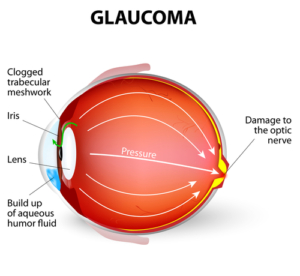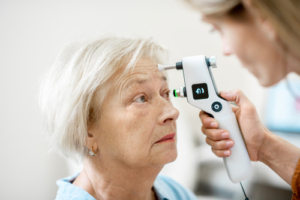What Makes Glaucoma The Secret Thief of Sight?

Did you know that more than 60 million people across the world have glaucoma? This group of disorders affects the optic nerve and can cause blindness.
Glaucoma is often called the secret or silent thief of sight. Keep reading to learn more about what makes glaucoma the secret thief of sight!
Glaucoma has Unclear Causes

The human eye has anterior chambers that are full of fluid between the cornea and the iris. Where the two areas meet, drains release fluid through sponge-like cells.
When the fluid inside the eye cannot drain, it increases and puts strain on the optic nerve. This increased pressure can permanently damage vision.
It harms the nerves that communicate with the brain and allows you to see the world around you. High fluid pressure in the eye is not always a sign that you will develop glaucoma.
Some people have optic nerves that have higher levels of pressure than others. Eye doctors are unsure how high eye pressure causes optic nerve damage.
The Symptoms of Glaucoma are Nonexistent or Gradual
People who have symptoms of glaucoma may not associate them with having glaucoma. For many, they may not realize they have glaucoma until they’ve already suffered irreversible vision loss from the condition.

They may lose some of their peripheral vision and not even notice it. Many people don’t seek treatment because they don’t know they could have a disease that can develop into blindness.
Open-angle glaucoma is the most common and mainly affects people over age 60. The disease occurs when the trabecular mesh near the cornea base is slightly blocked.
When this happens, fluid in the eye fluid cannot drain. Eye pressure increases slowly, causing pressure and stress to develop on the optic nerve.
Most people have no symptoms because the buildup develops gradually. Severe open-angle glaucoma can cause tunnel vision and blind spots.
Angle-closure glaucoma is also known as closed-angle glaucoma. It is a less common form of the condition that happens as the eye drainage canals are covered or blocked.
This can occur if pupils grow large when suddenly immersed in darkness. The change forces the iris to cover the drainage canals.
Acute angle-closure glaucoma symptoms happen suddenly. These symptoms can cause sudden headaches, nausea, eye pain, and blurry vision.
If you have acute angle-closure glaucoma, it is a medical emergency. You should see your doctor as soon as possible if you think you could have it, as you’ll need immediate treatment. Acting quickly can prevent further vision loss by releasing the pressure.
Red eyes, blind spots, and seeing halos around lights are signs of chronic angle-closure glaucoma. This disease gradually develops and places pressure on the optic nerve.
Pigmentary glaucoma is most likely to happen to men between the ages of 20 and 40. Nearsighted people are also at an increased risk of developing pigmentary glaucoma.
If you’re nearsighted, your eyes release pigments that can clog the drainage ducts. When this happens, it can lead to an increase in eye pressure.
Early symptoms are rare. As the disease worsens, some patients have blurry sight or see halos around lights. Others experience no symptoms and may learn they have the disease at a regular eye exam.
People can also have pigment dispersion syndrome that does not clog the ducts. You can have pigment dispersion syndrome and not have glaucoma.
Detecting and Preventing Glaucoma
The best way to prevent permanent damage from glaucoma is by having regular eye exams. If you don’t wear glasses or contacts and you’re under forty, you should see your eye doctor for an eye exam every one to two years.
If you’re older than forty, you should see your eye doctor every year. If you’re over 65, you should see your eye doctor for yearly eye exams, or more frequently, depending on their recommendation.

People over 65 should also get yearly exams. If you’re older than 70, your risk of developing open-angle glaucoma increases significantly. This is especially true if you’re comparing this to someone in their forties.
If you have a family history of glaucoma, this can also increase your risk of developing the condition. Your risk also becomes more heightened if you have diabetes or high blood pressure.
You should talk to your eye doctor to understand your risk. Your ophthalmologist may recommend making lifestyle changes that will help you get more healthy.
Glaucoma tests include examining inner eye pressure and corneal thickness. Your eye doctor will also assess your field of vision and look at the optic nerve’s color and shape.
Finally, they will measure the angle where the iris meets the cornea. This factor can increase your chances of developing the disease.
Treating Glaucoma
When it comes to treating glaucoma, the first treatment option that most eye doctors begin with is eye drops. These eye drops are not your ordinary eye drops.
Eye drops

Instead, these prescription eye drops help to lower eye pressure. By lowering eye pressure, glaucoma is stopped, or its progression is slowed down.
Some glaucoma patients may need several types of drops depending on their pressure measurements.
Selective Laser Trabeculoplasty (SLT)
For patients who struggle to take eye drops daily, a procedure like selective laser trabeculoplasty may be worth considering. This procedure increases fluid drainage to lower pressure.
For many patients, this can take one to three months.
Minimally Invasive Glaucoma Surgery (MIGS)
Minimally Invasive Glaucoma Surgery (MIGS) is a group of minimally invasive glaucoma procedures that can treat mild to moderate glaucoma. These procedures insert implants to keep the drain system open and prevent pressure buildup.
They use microscopic equipment and tiny incisions that heal quicker, leading to better results for patients. Another reason that MIGS procedures are often preferable is you can combine them with cataract procedures.
If a patient has cataracts and glaucoma, a MIGS procedure can treat both glaucoma and cataracts without detriment.
Severe Glaucoma Treatment Options
Eye doctors treat severe glaucoma with tubes, shunts, or trabeculectomies. These drainage implants quickly lower eye pressure and prevent future clogs from occurring. They have a more immediate and long-term result than SLT lasers and medicated eye drops.
Are you searching for a comprehensive glaucoma treatment plan? Eye Consultants of North Dakota is an eye care practice with a state-of-the-art facility.
Our eye doctors only use top-quality technology to care for patients of all ages. Schedule an appointment at Eye Consultants of North Dakota in Fargo, ND, today!



